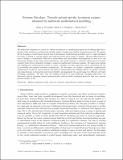Files in this item
Systems oncology : towards patient-specific treatment regimes informed by multiscale mathematical modelling
Item metadata
| dc.contributor.author | Powathil, Gibin G. | |
| dc.contributor.author | Swat, Maciej | |
| dc.contributor.author | Chaplain, Mark A. J. | |
| dc.date.accessioned | 2015-10-29T13:10:07Z | |
| dc.date.available | 2015-10-29T13:10:07Z | |
| dc.date.issued | 2015-02 | |
| dc.identifier | 206440203 | |
| dc.identifier | 5344ef13-5dc9-4fab-ada9-2e6e37c4c144 | |
| dc.identifier | 84919636142 | |
| dc.identifier.citation | Powathil , G G , Swat , M & Chaplain , M A J 2015 , ' Systems oncology : towards patient-specific treatment regimes informed by multiscale mathematical modelling ' , Seminars in Cancer Biology , vol. 30 , pp. 13-20 . https://doi.org/10.1016/j.semcancer.2014.02.003 | en |
| dc.identifier.issn | 1044-579X | |
| dc.identifier.other | RIS: urn:43DD675CB54D50809BED5ECB045BEA54 | |
| dc.identifier.other | ORCID: /0000-0001-5727-2160/work/55378855 | |
| dc.identifier.uri | https://hdl.handle.net/10023/7713 | |
| dc.description.abstract | The multiscale complexity of cancer as a disease necessitates a corresponding multiscale modelling approach to produce truly predictive mathematical models capable of improving existing treatment protocols. To capture all the dynamics of solid tumour growth and its progression, mathematical modellers need to couple biological processes occurring at various spatial and temporal scales (from genes to tissues). Because effectiveness of cancer therapy is considerably affected by intracellular and extracellular heterogeneities as well as by the dynamical changes in the tissue microenvironment, any model attempt to optimise existing protocols must consider these factors ultimately leading to improved multimodal treatment regimes. By improving existing and building new mathematical models of cancer, modellers can play important role in preventing the use of potentially sub-optimal treatment combinations. In this paper, we analyse a multiscale computational mathematical model for cancer growth and spread, incorporating the multiple effects of radiation therapy and chemotherapy in the patient survival probability and implement the model using two different cell based modelling techniques. We show that the insights provided by such multiscale modelling approaches can ultimately help in designing optimal patient-specific multi-modality treatment protocols that may increase patients quality of life. | |
| dc.format.extent | 8 | |
| dc.format.extent | 1265470 | |
| dc.language.iso | eng | |
| dc.relation.ispartof | Seminars in Cancer Biology | en |
| dc.subject | Hybrid multiscale model | en |
| dc.subject | Cell-cycle | en |
| dc.subject | Hypoxia | en |
| dc.subject | Chemotherapy | en |
| dc.subject | Radiation therapy | en |
| dc.subject | RC0254 Neoplasms. Tumors. Oncology (including Cancer) | en |
| dc.subject | QA Mathematics | en |
| dc.subject | QH301 Biology | en |
| dc.subject | NDAS | en |
| dc.subject | SDG 3 - Good Health and Well-being | en |
| dc.subject.lcc | RC0254 | en |
| dc.subject.lcc | QA | en |
| dc.subject.lcc | QH301 | en |
| dc.title | Systems oncology : towards patient-specific treatment regimes informed by multiscale mathematical modelling | en |
| dc.type | Journal article | en |
| dc.contributor.institution | University of St Andrews. Applied Mathematics | en |
| dc.identifier.doi | https://doi.org/10.1016/j.semcancer.2014.02.003 | |
| dc.description.status | Peer reviewed | en |
| dc.identifier.url | http://www.sciencedirect.com/science/journal/1044579X | en |
This item appears in the following Collection(s)
Items in the St Andrews Research Repository are protected by copyright, with all rights reserved, unless otherwise indicated.

